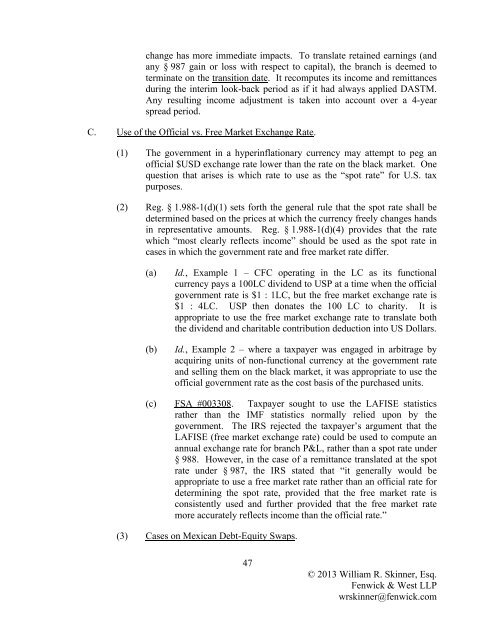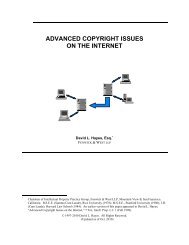International Tax Aspects of Foreign Currency Transactions
International Tax Aspects of Foreign Currency Transactions
International Tax Aspects of Foreign Currency Transactions
Create successful ePaper yourself
Turn your PDF publications into a flip-book with our unique Google optimized e-Paper software.
change has more immediate impacts. To translate retained earnings (andany § 987 gain or loss with respect to capital), the branch is deemed toterminate on the transition date. It recomputes its income and remittancesduring the interim look-back period as if it had always applied DASTM.Any resulting income adjustment is taken into account over a 4-yearspread period.C. Use <strong>of</strong> the Official vs. Free Market Exchange Rate.(1) The government in a hyperinflationary currency may attempt to peg an<strong>of</strong>ficial $USD exchange rate lower than the rate on the black market. Onequestion that arises is which rate to use as the “spot rate” for U.S. taxpurposes.(2) Reg. § 1.988-1(d)(1) sets forth the general rule that the spot rate shall bedetermined based on the prices at which the currency freely changes handsin representative amounts. Reg. § 1.988-1(d)(4) provides that the ratewhich “most clearly reflects income” should be used as the spot rate incases in which the government rate and free market rate differ.(a)(b)Id., Example 1 – CFC operating in the LC as its functionalcurrency pays a 100LC dividend to USP at a time when the <strong>of</strong>ficialgovernment rate is $1 : 1LC, but the free market exchange rate is$1 : 4LC. USP then donates the 100 LC to charity. It isappropriate to use the free market exchange rate to translate boththe dividend and charitable contribution deduction into US Dollars.Id., Example 2 – where a taxpayer was engaged in arbitrage byacquiring units <strong>of</strong> non-functional currency at the government rateand selling them on the black market, it was appropriate to use the<strong>of</strong>ficial government rate as the cost basis <strong>of</strong> the purchased units.(c) FSA #003308. <strong>Tax</strong>payer sought to use the LAFISE statisticsrather than the IMF statistics normally relied upon by thegovernment. The IRS rejected the taxpayer’s argument that theLAFISE (free market exchange rate) could be used to compute anannual exchange rate for branch P&L, rather than a spot rate under§ 988. However, in the case <strong>of</strong> a remittance translated at the spotrate under § 987, the IRS stated that “it generally would beappropriate to use a free market rate rather than an <strong>of</strong>ficial rate fordetermining the spot rate, provided that the free market rate isconsistently used and further provided that the free market ratemore accurately reflects income than the <strong>of</strong>ficial rate.”(3) Cases on Mexican Debt-Equity Swaps.47© 2013 William R. Skinner, Esq.Fenwick & West LLPwrskinner@fenwick.com
















